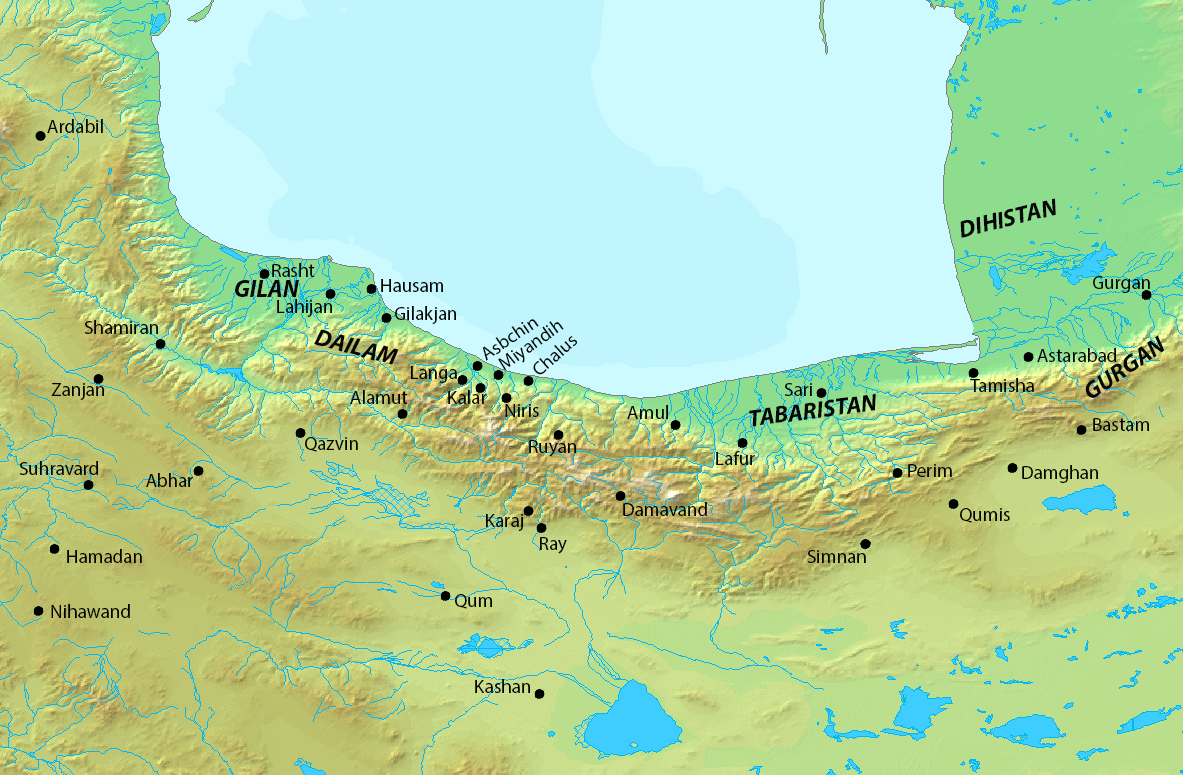|
Qarinid
The Qarinvand dynasty (also spelled Karenvand and Qarenvand), or simply the Karenids, was an Iranian dynasty that ruled in parts of Tabaristan (Mazandaran) in northern Iran from the 550s until the 11th-century. They considered themselves as the inheritors of the Dabuyid dynasty, and were known by their titles of ''Gilgilan'' and ''Ispahbadh''. They were descended from Sukhra, a Parthian nobleman from the House of Karen, who was the '' de facto'' ruler of the Sasanian Empire from 484 to 493. The Qarinvand dynasty is also considered to be one of the last Zoroastrian dynasties before the rise of the Islamic Iranian dynasties History The dynasty was founded by Karen, who in return for aiding the Sasanian king Khosrow I (r. 531–579) against the Turks, received land to the south of Amol in Tabaristan. During the 7th century, an unnamed ruler from the Qarinvand dynasty was granted parts of Tabaristan by the Dabuyids who ruled in the area. In 760, the Dabuyid ruler Khurshid was def ... [...More Info...] [...Related Items...] OR: [Wikipedia] [Google] [Baidu] |
Middle Ages
In the history of Europe, the Middle Ages or medieval period lasted approximately from the 5th to the late 15th centuries, similarly to the post-classical period of global history. It began with the fall of the Western Roman Empire and transitioned into the Renaissance and the Age of Discovery. The Middle Ages is the middle period of the three traditional divisions of Western history: classical antiquity, the medieval period, and the modern period. The medieval period is itself subdivided into the Early, High, and Late Middle Ages. Population decline, counterurbanisation, the collapse of centralised authority, invasions, and mass migrations of tribes, which had begun in late antiquity, continued into the Early Middle Ages. The large-scale movements of the Migration Period, including various Germanic peoples, formed new kingdoms in what remained of the Western Roman Empire. In the 7th century, North Africa and the Middle East—once part of the Byzantine Empire� ... [...More Info...] [...Related Items...] OR: [Wikipedia] [Google] [Baidu] |
Parthia
Parthia ( ''Parθava''; ''Parθaw''; ''Pahlaw'') is a historical region located in northeastern Greater Iran. It was conquered and subjugated by the empire of the Medes during the 7th century BC, was incorporated into the subsequent Achaemenid Empire under Cyrus the Great in the 6th century BC, and formed part of the Hellenistic Seleucid Empire after the Wars of Alexander the Great, 4th-century BC conquests of Alexander the Great. The region later served as the political and cultural base of the Eastern Iranian languages, Eastern Iranian Parni people and Arsacid dynasty, rulers of the Parthian Empire (247 BC – 224 AD). The Sasanian Empire, the last state of History of Iran, pre-Islamic Iran, also held the region and maintained the Seven Great Houses of Iran, seven Parthian clans as part of their feudal aristocracy. Name The name "Parthia" is a continuation from Latin language, Latin ', from Old Persian ', which was the Parthian language self-designator signifying "of the Pa ... [...More Info...] [...Related Items...] OR: [Wikipedia] [Google] [Baidu] |
Zoroastrian
Zoroastrianism ( ), also called Mazdayasnā () or Beh-dīn (), is an Iranian religion centred on the Avesta and the teachings of Zarathushtra Spitama, who is more commonly referred to by the Greek translation, Zoroaster ( ). Among the world's oldest organized faiths, its adherents exalt an uncreated, benevolent, and all-wise deity known as Ahura Mazda (), who is hailed as the supreme being of the universe. Opposed to Ahura Mazda is Angra Mainyu (), who is personified as a destructive spirit and the adversary of all things that are good. As such, the Zoroastrian religion combines a dualistic cosmology of good and evil with an eschatological outlook predicting the ultimate triumph of Ahura Mazda over evil. Opinions vary among scholars as to whether Zoroastrianism is monotheistic, polytheistic, henotheistic, or a combination of all three. Zoroastrianism shaped Iranian culture and history, while scholars differ on whether it significantly influenced ancient Western ... [...More Info...] [...Related Items...] OR: [Wikipedia] [Google] [Baidu] |
Daylamites
The Daylamites or Dailamites (Middle Persian: ''Daylamīgān''; ''Deylamiyān'') were an Iranian people inhabiting the Daylam—the mountainous regions of northern Iran on the southwest coast of the Caspian Sea, now comprising the southeastern half of Gilan Province. The Daylamites were warlike people skilled in close combat. They were employed as soldiers during the Sasanian Empire and in the subsequent Muslim empires. Daylam and Gilan were the only regions to successfully resist the Muslim conquest of Persia, although many Daylamite soldiers abroad accepted Islam. In the 9th century many Daylamites adopted Zaidi Islam. In the 10th century some adopted Isma'ilism, then in the 11th century Fatimid Isma'ilism and subsequently Nizari Isma'ilism. Both the Zaidis and the Nizaris maintained a strong presence in Iran up until the 16th century rise of the Safavids who espoused the Twelver sect of Shia Islam. In the 930s, the Daylamite Buyid dynasty emerged and managed to gain control ... [...More Info...] [...Related Items...] OR: [Wikipedia] [Google] [Baidu] |
Daylam
Daylam (), also known in the plural form Daylaman () (and variants such as Dailam, Deylam, and Deilam), was the name of a mountainous region of inland Gilan, Iran. It was so named for its inhabitants, known as the Daylamites. The Church of the East established a Dioceses of the Church of the East to 1318, metropolitan diocese for Daylam and Gilan around 790 under Shubhalishoʿ., p. 166. See also *Buyid dynasty *Daylami language *Talysh people *Al-Daylami (other), al-Daylami *Zaydiyyah *Nizari Ismaili state References Bibliography * Historical regions of Iran History of Gilan {{Iran-geo-stub ... [...More Info...] [...Related Items...] OR: [Wikipedia] [Google] [Baidu] |
Vindadhhurmuzd
Vindadhhurmuzd (Persian: ونداد هرمز), also known by the more correct form of Vandad Hormozd (ونداد هرمزد), was the ruler of the Qarinvand dynasty from 765 to 809. Background In 760, during the reign of Vandad Hormozd's father, whose name is unknown, the Dabuyids, under Khurshid of Tabaristan, revolted against the Abbasid Caliphate. Khurshid was defeated, however, and fled to Daylam. From there he launched a counterattack against the Abbasids, but was once again defeated. After learning that his family was captured by the Abbasids, Khurshid poisoned himself.Rekaya (1986), pp. 68–70Madelung (1975), p. 200Pourshariati (2008), p. 317 This marked the end of the Dabuyid dynasty, but the other local dynasties such as the Qarinvands, Bavandids and Zarmihrids, who were all formerly subject to the Dabuyids, continued to control parts of Tabaristan, as tributary vassals of the Abbasid government. Biography In 765, Vandad Hormozd became the ruler of the Qarinvand ... [...More Info...] [...Related Items...] OR: [Wikipedia] [Google] [Baidu] |
Abbasid Caliphate
The Abbasid Caliphate or Abbasid Empire (; ) was the third caliphate to succeed the Islamic prophet Muhammad. It was founded by a dynasty descended from Muhammad's uncle, Abbas ibn Abd al-Muttalib (566–653 CE), from whom the dynasty takes its name. After overthrowing the Umayyad Caliphate in the Abbasid Revolution of 750 CE (132 AH), they ruled as caliphs based in modern-day Iraq, with Baghdad being their capital for most of their history. The Abbasid Revolution had its origins and first successes in the easterly region of Khurasan, far from the Levantine center of Umayyad influence. The Abbasid Caliphate first centered its government in Kufa, modern-day Iraq, but in 762 the caliph al-Mansur founded the city of Baghdad as the new capital. Baghdad became the center of science, culture, arts, and invention in what became known as the Golden Age of Islam. By housing several key academic institutions, including the House of Wisdom, as well as a multiethnic and multi- ... [...More Info...] [...Related Items...] OR: [Wikipedia] [Google] [Baidu] |
Khurshid Of Tabaristan
Khurshid (Book Pahlavi: hwlšyt'; Tabari/, Spāhbed Khōrshīd 'General Khorshid'; 734–761), erroneously designated Khurshid II by earlier scholars, was the last Dabuyid '' ispahbadh'' of Tabaristan. He succeeded to the throne at an early age, and was supervised by his uncle as regent until he reached the age of fourteen. Khurshid supported various rebellions and maintained diplomatic contacts with Tang China. Finally, the Abbasids conquered his country in 759–760, and captured most members of his family. Khurshid fled to Daylam, where he ended his life. Biography Khurshid was born in 734/735, the son of Dadhburzmihr or Dadmihr (died 740) and grandson of Farrukhan the Great (died ca. 728), the first ruler ('' ispahbadh'') of the Dabuyid dynasty from whose reign coins are known.Rekaya (1986), pp. 68–70Madelung (1993), pp. 541–544 According to the traditional account, the Dabuyids had established themselves as the autonomous rulers of Tabaristan in the 640s, during t ... [...More Info...] [...Related Items...] OR: [Wikipedia] [Google] [Baidu] |
Amol
Amol ( ; ) is a city in the Central District (Amol County), Central District of Amol County, Mazandaran province, Mazandaran province, Iran, serving as capital of both the county and the district. Amol is located on the Haraz River bank. It is situated less than south of the Caspian Sea and less than north of the Alborz mountains. It is northeast of Tehran, and west of the provincial capital, Sari, Iran, Sari. It is one of the oldest cities in Iran, and a historic city, with its foundation dating back to the Amardi tribe, who inhabited the region in the Iron Age. Amol is the center of industry and culture of Mazandaran, the rice capital of Iran, and one of the most important cities of the transportation, agriculture, and tourism industries in Iran. It is known as the ''History, Science and Philosophy city'', ''City that does not die'' and ''Hezar Sangar city''. History Pre-Islamic era According to the city government, the name is derived from ''Amardi'', a tribe mentioned ... [...More Info...] [...Related Items...] OR: [Wikipedia] [Google] [Baidu] |
Western Turkic Khaganate
The Western Turkic Khaganate () or Onoq Khaganate () was a Turkic khaganate in Eurasia, formed as a result of the wars in the beginning of the 7th century (593–603 CE) after the split of the First Turkic Khaganate (founded in the 6th century on the Mongolian Plateau by the Ashina clan), into a western and an eastern Khaganate. The whole confederation was called ''Onoq'', meaning "ten arrows". According to a Chinese source, the Western Turks were organized into ten divisions. The khaganate's capitals were Navekat (summer capital) and Suyab (principal capital), both situated in the Chui River valley of Kyrgyzstan, to the east of Bishkek. Tong Yabgu's summer capital was near Tashkent and his winter capital Suyab. The Eastern Turkic Khaganate was subjugated by the Tang dynasty in 657 and continued as its vassal, until it finally collapsed in 742. To the west, the breakup of the Western Turkic Khaganate led to the rise of the Turkic Khazar Khaganate (–969). History The ... [...More Info...] [...Related Items...] OR: [Wikipedia] [Google] [Baidu] |
Khosrow I
Khosrow I (also spelled Khosrau, Khusro or Chosroes; ), traditionally known by his epithet of Anushirvan ("the Immortal Soul"), was the Sasanian King of Kings of Iran from 531 to 579. He was the son and successor of Kavad I (). Inheriting a reinvigorated empire at war with the Byzantines, Khosrow I signed a peace treaty with them in 532, known as the Perpetual Peace, in which the Byzantine emperor Justinian I paid 11,000 pounds of gold to the Sasanians. Khosrow then focused on consolidating his power, executing conspirators, including his uncle Bawi. Dissatisfied with the actions of the Byzantine clients and vassals, the Ghassanids, and encouraged by Ostrogoth envoys from Italy, Khosrow violated the peace treaty and declared war against the Byzantines in 540. He sacked the major city of Antioch and deported its population to Persia. In 541, he invaded Lazica and made it an Iranian protectorate, thus initiating the Lazic War. In 545, the two empires agreed to halt the wars in ... [...More Info...] [...Related Items...] OR: [Wikipedia] [Google] [Baidu] |






